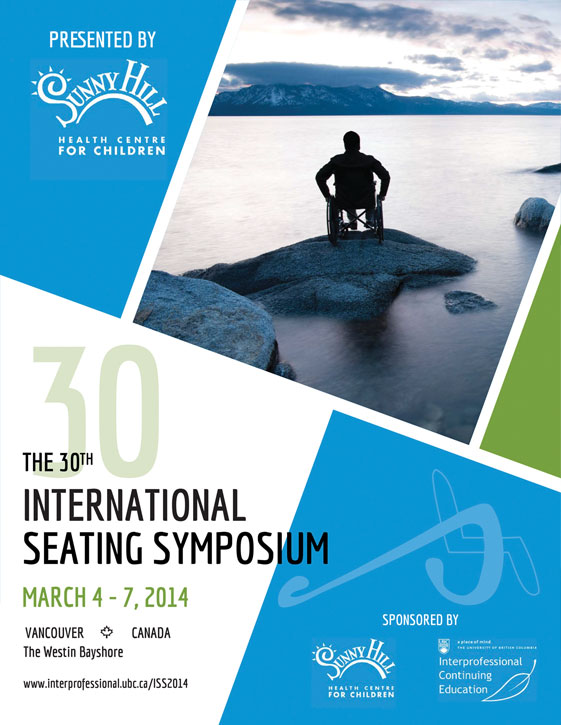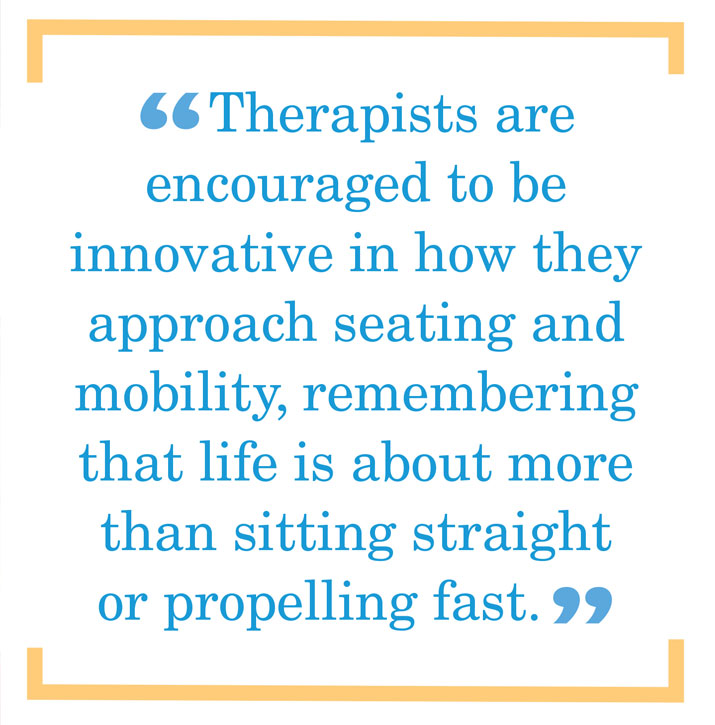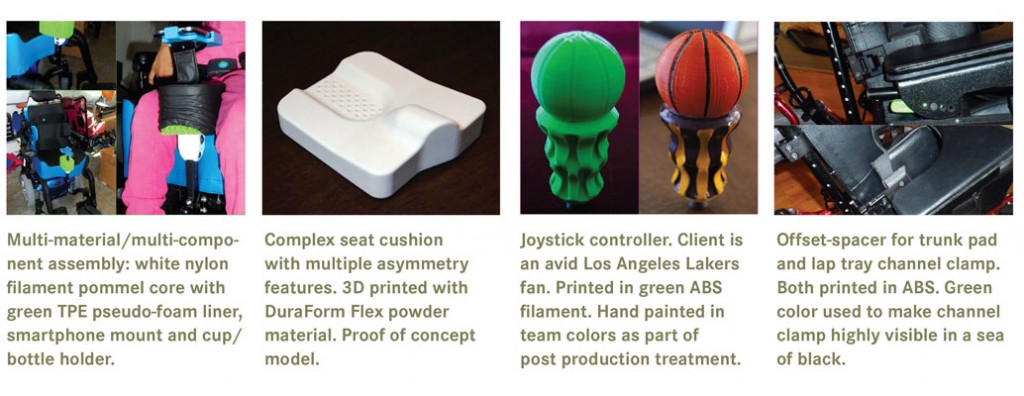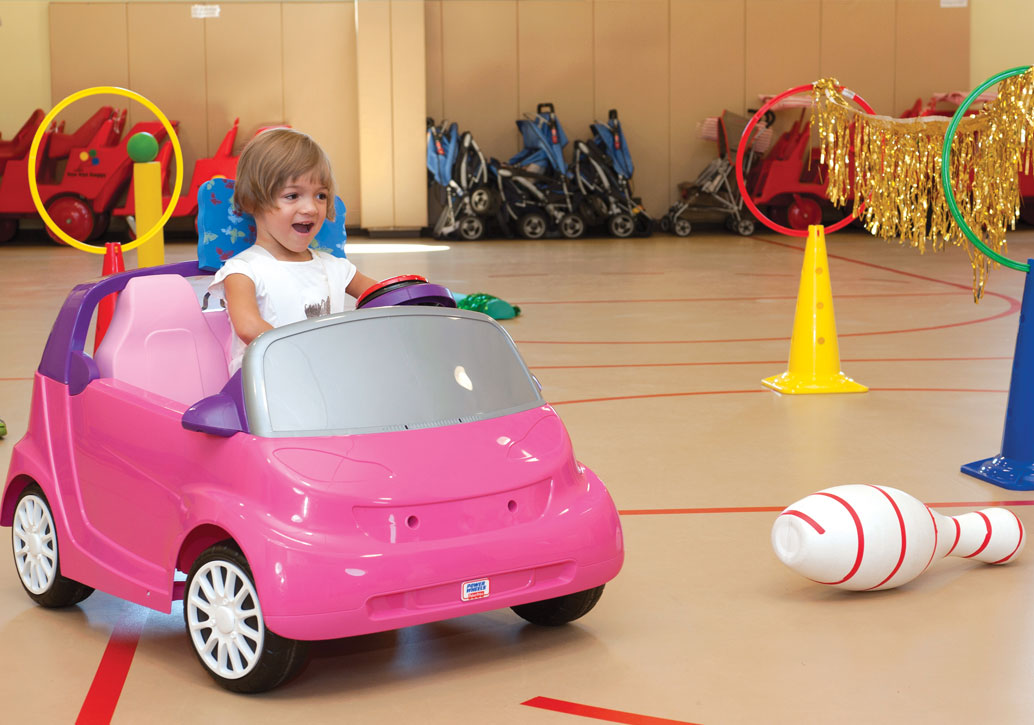Encouraging experimental and innovative approaches
Vancouver’s Sunny Hill Health Centre for Children (SHHC) and the University of British Columbia celebrated their 30th International
(SHHC) and the University of British Columbia celebrated their 30th International
Seating Symposium in Vancouver this March. This conference is considered to be one of the premier meetings in the world of dedicated researchers, clinicians, manufacturers and others who work to improve seating and mobility among people with disabilities.
It was a journey that started in 1982, with a desire from clinicians at SHHC and BC’s Children’s Hospital to learn more about the intriguing subjects of seating and mobility. A seating special interest group was established in Vancouver, which then decided that the best way of learning more about seating and mobility was to bring the experts to them. Getting funding to host the first conference was a challenge, but the BC Kinsmen Foundation took the risk. The initial organizers, Maureen Story, Dave Cooper, Elaine Liau and Dr. Stephen Tredwell, brought clinicians, researchers and exhibitors together to develop resources and create a forum that fostered an exchange of ideas. Together, the participants created a network focused on seating and mobility.
The first meeting, in 1983, had 98 participants and 11 exhibitors, with a focus on “seating the disabled.” By 2014, the event had grown to include nearly 1150 participants from 27 countries and more than 100 exhibitors. Partner conferences now take place around the world, including events in the USA, Ireland, Brazil and Asia. Today’s mandate is not significantly different from that of the 1980s, although the approach to seating now focuses much more on mobility.
Developing nations
Dave Calver, is a practicing occupational therapist who himself has a spinal cord injury. He uses a wheelchair full time and educates therapists in developing nations on seating that enables mobility appropriate for their country’s geography and socioeconomic situations. Therapy has changed from helping people sit well to being mobile, wherever they might be. There is definitely a trend towards more involvement in developing nations.
Knowledge is power. No barriers.
These are statements that dominate my mind coming away from a week in Canada at the International Seating Symposium. They were messages delivered with overarching conviction from Dave Calver, an L3 paraplegic with an inspiring story to tell.
Calver had an accident mountain biking in Kamloops British Columbia over 10 years ago. At the time he was a guide in the adventure tourism industry working on rivers all over the world and trekking trips in the Himalayas.
Following the accident, he was the only person under 70 in rehab at the local hospital. Calver’s physiotherapy consisted of passing a netball in the gym. This guy was a young white water rafting guide and mountain biker and he decided quickly to take matters into his own hands with his recovery. Eventually, this led him to complete a Masters in Occupational Therapy.
Calver says, “Initially, I believed my injury meant a loss of opportunity and mobility. But now I no longer believe there have been limitations in my opportunities… but I am still looking!”
Some years on and Calver is back on the river guiding trips in British Columbia, the US and Latin America. He’s been instrumental in programs to help other individuals with disabilities access the wilderness, and he has been involved in wheelchair development projects in East Timor, Sri Lanka, Afghanistan and India.
Calver tells a gripping story of when he was in East Timor eight years ago training clients with SCI. “All participants had Grade 4 pressure sores. Life expectancy for people in third world countries with SCI is two years due to pressure sores or bowel/bladder management issues.” All the participants of that particular course are alive and well today thanks to the work of Calver and others. This really gave me pause for thought considering the situation of those in less fortunate countries than ours. Such mortality rates are unheard of in Australia. Which brings me back to Calver’s two mantras – “knowledge is power” and “no barriers”.
The thing is, it’s easy for us all to set limitations on ourselves and our clients even subconsciously. Dave reminds us anything is possible and to keep pushing the barriers.
Submitted by Jason Lowe
GoBabyGo: The drive to explore
When Cole Galloway takes his research-show on the road, one of his favourite things to share with the audience is a video of a newly mobile baby wreaking havoc in a living room filled with toys. Galloway heightens the effect by showing the movie at triple speed, so that the audience quickly becomes as exhausted as both the baby and her parents at the end of a day.
As a physical therapist and developmental scientist, Galloway knows that the basic movement behaviours of kids between the ages of one and three years—the so-called “toddler years”—are more than just movements. The continuous stream of activity is a complex “exploratory engine” that children use to build bigger, better bodies, construct more complex brains, form their first friendships and lay the foundations for school readiness.
“Adults have long recognized that children’s brains and behaviours expand during the early years,” Galloway says. “More recent is the recognition that their mental, social and emotional development is intimately linked to their physical and social exploration of the world. For adults trying to keep up with a toddler, exploration can be simultaneously frustrating, exhausting and exhilarating.
“Toddlers will paint your new furniture with chocolate pudding, force pants into the dishwasher and try to ride the cat—and that’s all before breakfast,” he continues. “As a developmental scientist, I’m interested in quantifying the who, what, when, where, why and how of these ‘babies gone wild.’ As a clinical scientist, I want to help create the technology that will allow children with special needs to become wild, and all families to discover the ‘engines’ within their children.”
To Galloway, the exploration gap between typically developing children and those with mobility issues is simply unacceptable, and he has devoted much of his career to doing something about it. Several years ago, he began working with mechanical engineering professor Sunil Agrawal, now at Columbia University, to develop robot-enhanced devices that provide mobility to children as young as six months.
Closing the gap
The University of Delaware (UD) was the ideal place to launch their collaboration. Agrawal’s Mechanical Systems Laboratory provided the “manufacturing plant” for the vehicles, while the university’s Early Learning Center (ELC) provided the young drivers, indoor and outdoor “test tracks,” and expert early educators and paediatric therapists such as Tracy Stoner and Terri Peffley.
The data collected using robots developed in the first phases of the project convinced Galloway and Agrawal that they were on the right track.
“Driving Sunil’s robots literally provided children who were not crawling or walking with a vehicle for exploration,” Galloway says. “The onset of crawling and walking is a causal factor for cognitive, emotional and social development. Powered mobility via driving appears to be a similar trigger for developmental change in young children who are not walking.”
“Mobility and socialization typically co-develop over the first two years of life,” he adds. “If they don’t, the child may end up with ‘splinter’ skills in which mobility and socialization emerge separately.”
As Galloway and his team discovered when they placed a mobility robot in an ELC preschool class, children who have experienced several years of immobility may learn to drive without understanding how to use their newfound mobility to play with friends or teachers.
“We realized then that we needed to start our driver training during infancy, in activities with other children and always in natural environments such as the ELC,” he says. “Our hope is that mobility and socialization will co-emerge for the driving toddler, just as they do for the walking toddler.”
 High-tech + low-tech = Go-Tech
High-tech + low-tech = Go-Tech
By 2010, the science and technology in the project were emerging, but the pace of development was a challenge for Galloway. With no new commercial devices on the market to provide early power mobility, he became increasingly frustrated at his inability to help parents, clinicians and educators who were excited about the work but wanted immediate help for their children.
“We were moving at the speed of science, which is of course acceptable at some level,” he says. “However, constantly saying ‘no’ to a community asking if we had robots for their children or clinic began to drive me a bit nutty.”
Galloway is a bit of a toddler himself. Like a child in the throes of the “terrible twos,” he does not like the word “no.” So he adopted another behaviour common to devious youngsters—if dad says no, ask mom … or, better yet, climb up and get it yourself.
One day about a year ago, he found himself at Toys R Us admiring a colourful array of plastic ride-on cars and trucks. After buying an assortment of the inexpensive vehicles, he went to Jo-Ann Fabric & Crafts and Home Depot, where he bought fabric, foam, straps, fasteners and PVC pipe. Back on campus, Galloway and his students began using the materials to customize the cars for use by individual kids.
Babies Driving Robots had spun off a new project: Babies Driving Racecars. Galloway says the low-tech is not replacing the high-tech, but complementing it.
“Like children, scientists thrive on trial-and-error learning cycles,” he says. “For real impact, you want those cycles to be rapid and cheap with clear, meaningful results. By modifying off-the-shelf toy cars, we can make lots of low-cost mistakes and quickly arrive at a range of ideal design features. That knowledge can then be fed back into ongoing robotics work.”
Galloway’s inner toddler was becoming a bit calmer. “Marrying the high-tech to the low-tech is leading us to new ‘Go-Tech’ possibilities in which scientific rigor is strapped to a race car,” he says.
The ubiquitous presence of the cars is also paving the way for globalization of the program. “It’s not uncommon to find distributors of ride-on toy cars in countries that don’t have stable governments or clean water for their citizens,” Galloway says. “This takes us from having two robots in-house here at UD to millions of toy cars around the world. The potential for such rapid globalization stretches our creative thinking about car modification design, as well as our scientific methods.”
It takes a village
Within the past year, GoBabyGo has taken off across the USA and even around the globe, as community groups use guidelines and toolkits created in Delaware to modify cars to meet the needs of individual kids. Videos and photos are shared on the UD GoBabyGo Facebook page (www.facebook.com/UDGoBabyGo), providing further fuel for the race-car project.
Galloway emphasizes the importance of doing this right. “We make sure to stay within the manufacturers’ intent, which is to use these cars as toys,” he says. “They’re not medical devices. We don’t alter their use, and we don’t alter the safety factors built into the cars. In fact, several of our modifications increase the safety for children with special needs.” The next step is to determine how many of the high-tech advances incorporated into the robotic devices developed in the laboratory can be added into the low-tech platform. Potential add-ons include force and motion sensors, GPS, web cameras and performance-tracking capabilities such as onboard microcomputers. This will allow laboratory-grade data gathered from living rooms, playgrounds and backyards around the world to be sent to the new Paediatric Mobility Lab and Design Studio on UD’s STAR Campus.
Several years ago, Galloway envisioned programming a device to take a child to the edge of a group, to just wander or to follow a specific child or an instrumented toy such as a ball. “This capability would enable us to place the child in the flow of the social scene and see what happens,” says Galloway.
His overriding goal is to get the technology into every possible environment that welcomes kids —from homes and playgrounds to preschools and even long-term care facilities for medically fragile children. “This project demands that our research stays nested deeply within the community,” says Galloway. “Discussing the technology and training of powered mobility with community audiences, from third-graders to business leaders, is a key connection. This project has something for everyone.”
Fun is fundamental
Galloway emphasizes that in both the low- and high-tech realms of his research, the use of mobility devices never replaces efforts to develop a child’s own ability to walk and run.
“Providing mobility and exploration with these cars likely helps encourage their exploratory ‘drive,’” he says. “For example, typically developing infants who spent 30 minutes a few times a week driving both crawled and walked early, and had advanced cognitive and language scores. Our future work needs to test this with children with special needs.”
Galloway never stops looking for creative ways to help individual children, while also seeking avenues to spread the message and the technology to parents and clinicians. One idea he is currently exploring is to pilot race-car camps. The research team would outfit the campers with cars, spend a week teaching them to drive, and then send the kids and cars home. The children’s progress would be monitored for the next six to nine months.
“Fun is the beginning and the end for our science,” Galloway says. “Our entire paediatric mobility program is built on a foundation of maximum fun and discovery. When your main goal is providing socialization for infants and toddlers, you can’t ask for better collaborators than Barbie and Mater.”
Adapted with permission from the University of Delaware. For more information about the program, visit www.udel.edu/gobabygo.
3D Printing Technologies:
The Future Of Complex Rehab Product Design
Consider this slogan: “Any material, any form, anywhere.” It declares absolute confidence in a technology that has been quietly evolving as a significant tool in a number of well healed industries: automotive, aircraft, aerospace, military, biomedicine, dentistry and several consumer products.
3D printing represents a class of emerging technologies that allow anyone to produce a physical product or structured mass via digital data and without having to first create a mold or jig. This simple and direct manufacturing process is expected to have profound impact in high-value, low-volume industries such as adaptive technology and custom seating fabrication. The elimination of tooling will allow for on-site manufacturing of customized products; rescinding the need for central stock- control and distribution. This radically new supply model will in turn improve lead times and decrease inventories. An additional advantage of 3D printing technology is the reduction of waste materials and toxic byproducts, thereby cutting overall production costs even further.
In the coming years, highly evolved service delivery models will no longer be constrained by limited access to technical talent or centralized workshop facilities. Instead, they will be driven by the manipulation and transfer of electronic data, the assimilation of graphics specialists (as designers or service personnel) and most importantly, the development of highly integrated knowledge- based processing systems. Realizing such changes will dramatically affect the way human-centric manufacturing industries (such as complex rehab) operate or cause so much decentralization of expertise that the current support structure within these industries may cease to exist altogether. There may even come a time when each rehab engineer will divert so much into their own paths of conviction (of what is do-able) that our current understanding of the delivery model will seem grossly inept.
Since 1990, 3D printing has quietly made its way into several prosthetic and orthotic research laboratories. Projects funded by government agencies and multinational corporations are now undergoing well supervised clinical trials. Though much more strength and quality control research is still required it may not be long before these near complete service delivery models will undergo widespread field testing. The unique aspect of 3D printing technology is that, at some future point, current industry-dominating manufacturers may find it hard to curtail the proliferation of such products and service models by independent mobile operators. The decentralization of control will extend to the front lines in which subtle but necessary changes in product design will be thoroughly undertaken by RTS/graphics specialists as a result of their direct client interactions and knowledge of computer based systems.
That slogan: “Any material, any form, anywhere” will test our limits of imagination and tolerance for patience and diminishing control. Consider, that the client base for this new technology will not be restricted to wheelchair dependent consumers but will include many consumers from the general population, seeking comfort, convenience and intimately personalized products and services.
Imagine a point-of-sale world where there is no need to inventory finished products. Seating components such as hardware and cushions are customized and produced with the aid of a 3D printer and knowledge-based program that requires no clinician, just the expertise of a graphics specialist. In this future world, the seating clinic is a cabinet sized 3D printer that can be transported to the consumer if necessary. What once took weeks will take days and what once required fabrication arenas and generous sized operating facilities will only require a desktop with closet space or a cargo van with driver/graphics artist.
Need a custom bracket or mounting device? Select a drawing, tweak it to your client’s requirements and print it. Need a complex cushion? Capture the profile in 3D, select posture and performance goals, define pressure and suspension gradients, then press “Enter”. By next morning (or later that afternoon) you’re ready for a confirmation fitting and delivery. There will be no need for an upholsterer because the cushion will constitute a lattice structure with built-in temperature controls and embedded fasteners (if necessary). What we know as upholstery today will be printed without seams and in your client’s choice of embellishing details. For safety and control, the underside of the cushion will be imprinted with all relative warnings, instructions for care and Mfr/FDA tracking IDs. Eventually, seating systems will evolve to have shape altering features to compensate for dynamic weight shifts and other posture influencing activities. And don’t forget the wireless connections that will provide an endless stream of performance data. Sitting comfort and posture control will take on meanings well beyond what is deemed acceptable by today’s standards.
So how far are we from this future world where end-use products are manufactured directly from digital data? The transformation is currently underway. Most of the technological elements are already available but lack cohesive integration. Once research has reached a point of confidence, independent, pay-for-service rehab specialists will likely be the first pioneers to market. It is now plausible that we’ll start seeing the first uniform offerings come to the fore, not from the big guys but via mid-sized operators. From there on, it will be just another few years before freelance operators will begin to offer cheaper and more accessible bits and pieces of the puzzle. After that it will truly be an open-source free-for-all because the materials, machines and operating programs will be obtainable by almost anyone at unbelievably low costs. What is yet unclear is how funding agencies and regulators will view this, but given current conditions, lower pricing with equal performance will tip the scale towards 3D printing.
Currently, many of the technological leaps in 3D printed products have been put forth, not by industry specialists but by everyday hobbyists and abstract thinkers. Printed handguns, orthotic devices and fashion-centric prosthetic appliances have all been brought to the fore via newsworthy experiments and achievements by technology geeks, enthusiasts and everyday people, willing to push against the wall of convention. Both consumer grade 3D printers and the open-source software that run them (no purchase required) are now available through a multitude of retail outlets. It is now possible for anyone, with no prior knowledge, to purchase,self-train and engage a 3D printer to produce (for their own benefit or for that of others) an orthotic device, splint, brace or other orthopedic appliance. If this industry does not embrace the emerging technologies of 3D printing then the industry as a whole may become plucked apart by laymen willing to prove naysayers and doubting Thomas’s wrong. Individuals who stop their quest for notoriety for no one and operate beyond the walls of professional associations, ethics, codes of conduct or even common sense. From a clinical perspective, for everything to come together, materials, tolerances, processes and performance parameters must continue to improve. Knowledge-based programs (knowledge banks) through which all clinical findings must be filtered will be the most proprietary piece of the puzzle. It is this crucial element that remains almost nonexistent throughout the industry. To obtain reliable consistency from boxed intelligence requires a sound philosophical base of understanding of the physics and mechanics of compromised seated posture.
In the meantime, the implications for this industry are that a present day, entry level seating specialist (clinician, fabricator, RTS, etc.) must start to tune-in and turn-on to a whole new way of viewing their product connected profession. Each will have to ponder which production/clinical philosophy to embrace and pursue. If you have more than five years left in your career, I think the time to start planning for this new-age curriculum and career path is now.
Richard Pasillas, is the owner of CUSHMAKER.com and the designer/creator of the 3D cushion. The material presented is a result of his research and applications.













